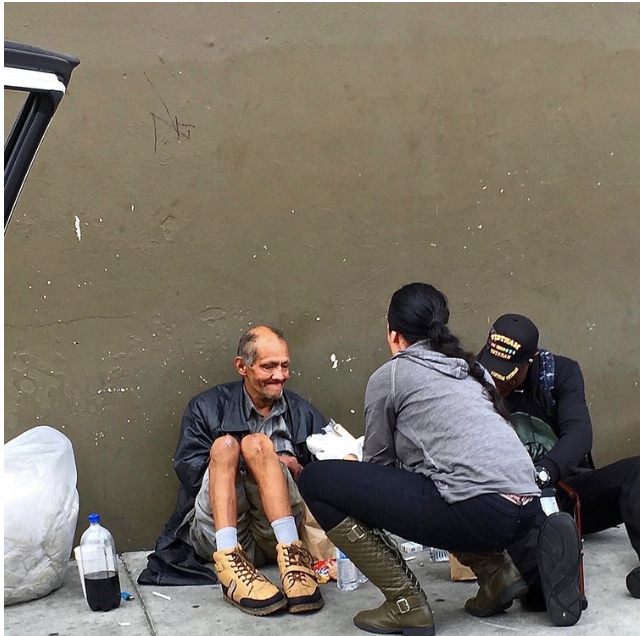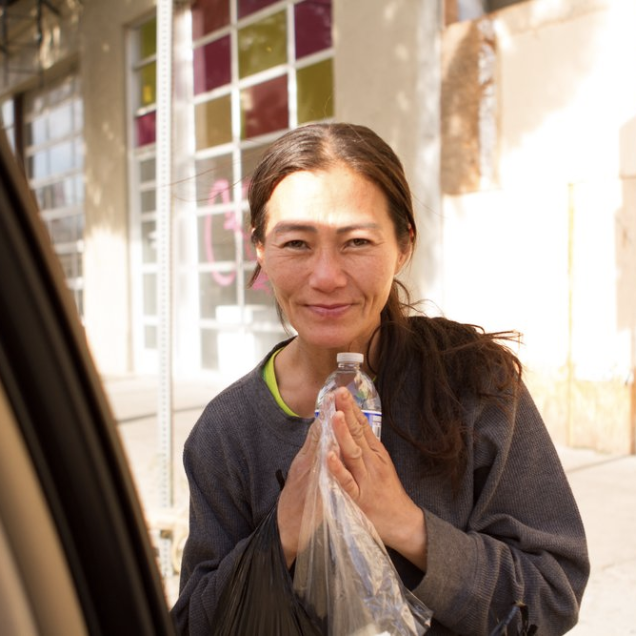What is Skid Row? How did it start? How do we help?
WHAT IS SKID ROW? HOW DID IT START?
1900-1920:
What is Skid Row? How did it Start?
1900-1920:
* "Hobo Corner" had thousands of men by 1900 - many left over from the Civil War, plus migrant workers brought in on boxcars to help build local railroads and infrastructure.
* Cheap hotels, saloons, brothels popped up to serve the demographic. Men did not want to leave. Cheap living, sunshine and easy labor could be found near the rail yards.
* Police who were fed up with the alcohol, mental illness, and violence that gripped the hub. They cracked down with government and resident approval.
* L.A. Times wrote: "Don't help this class." "It's a crime against the community to do it." They are "scum of the gutters," "two-legged hogs."
* Men arrested in "hobo sweeps" were sentenced to chain gangs, ironically sentenced to build our railroads and infrastructure.
* Religious, charitable groups formed "missions" to provide food, shelter for those released from jail or mental institutions. They charged a 5 cents per cot. Those lacking a nickel could sleep on floors or benches.
1990 forward:
* For decades, homeless released from local jails or asylums were deposited upon the Skid Row area.
* By the 1990s, mental institutions east and north of Skid Row were defunded, de-institutionallized and closed down. L.A. failed to provide promised outpatient services.
* Adults with mental issues and no access to medication, coupled with migrant workers and addicts who inhabited the area, gave rise to our modern day Skid Row.
* Section 8 housing vouchers, food stamps and general relief payments for the poor are available, but hard to get. Many can't (or don't) qualify.
* Today, Skid Row is comprised of 20-square-blocks of warehouse sidewalk. Building owners get large tax breaks for allowing homeless to live on the sidewalks in front of their structure.
Today on Skid Row:
* 11,000 people live on Skid Row streets.
* Very few bathrooms exist on those streets. Buckets are bathrooms, situated behind their tents.
* Syrian refugee camps have 96% more toilets than currently exist on Skid Row. 106 new toilets would have to be implemented to match even those unacceptable conditions.
* No water fountains exist on Skid Row or L.A. public streets.
* 56,000 homeless live in L.A.County as of May, 2018
* 134,000 homeless live in California.
WHAT DBDG DOES TO SPECIFICALLY HELP:
DBDG is a grassroots nonprofit. No overhead. No agenda.
We offer water, body wipes, protein, socks to adult homeless on the streets.
Our mission is to offer “hydration and hygiene to the heart of the homeless” focusing on the disabled and elderly who can't reach services.
Every week, we drive the poorest areas and much like an ice-cream truck, we offer basic essentials from our car windows.
Our aim is simple: to improve the hygiene and living conditions of homeless Americans who have no access to public toilets, bathing facilities, drinking fountains or permanent covered shelters.
By driving directly to where the needy have been displaced, we can fill in the gaps where other service providers leave off.
We do this with no agenda and no judgment. We are not political. We are temporary help.
DBDG is a truly home-grown 501c3. We rely solely on donations and operate with almost no overhead in order to put every donated dollar to immediate use.
A mere $4.00 a month is all it takes to become a DBDG Sustaining Member at: https://goo.gl/PNARZ
What sets us apart is our simple business model: Anyone with a steering wheel and an extra bottle of water can be a Drive-By Do-Gooder.
Whether you're a commuter or a kid, all you have to do is roll down the window, and offer something to someone in need.
Water and wipes are needed. Kids love volunteering with us! The rush they get of multiple "thank you's" and "bless you's"
t breaks the stigma of seeing adults look sad and standing there and makes all that help feel good!
We legally sign off on student community service hours from all schools in L.A.
When was the last time that you'd heard of a charity that asks for just $4 a month and that donation can be traced from you to the needy directly.
SCOPE of the HOMELESSNESS CRISIS:
* L..A. County has 56,000 homeless, an increase o 42% from 2010 as of May 2018.
* Skid Row has the largest homeless population, with 11,000 currently on its 25 blocks of streets or shelters.
* 11% of all California college students are homeless, as of Aug. 2018.
* Rent for a studio apartment has climbed 92%.
* Bad luck, series of mistakes, work loss and fleeing from abusive marriages are common contributors to current adult homelessness.
*Those who’d become homeless for the first time jumped 16% from 2017 to nearly 10,000 people.
* More than 15,700 people sleep in 9,100 vehicles every night on L.A. streets. These vehicle-dwellers represent over 25% of the homeless population in L.A. County.
* 1/3 of addicted and mentally-ill patients have moved here from other states. [cite?]
* L.A. County needs an additional 568,000 affordable units to meet the demand of lowest-income renters.
* L.A. taxpayers voted to raise taxes twice (2016-2017) to fund a multi-billion dollar, 10-year program to build affordable units to meet demand of lowest-income renters. However, many tax-payer dollars are tied up in court battles between developers, politicians and government officials.
* Children and families are cared for first. Adults who qualify for "Section 8 vouchers" and "general relief payments" wait on lists ranging from 2 to 8 years.
* Foster youth who age out of institutions, and state convicts released from them, are dropped off in Skid Row upon release if they have no home.
*California has 134,000 homeless, the most in the nation. L.A. County has almost half that population, also the most in the nation.
* Homeless adults with higher rates of chronic problems visit the ER multiple times per year. Each 3-day visit can cost over $9,000, or close to $44,000 a year.




